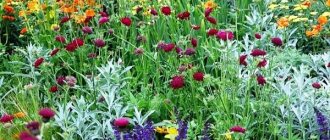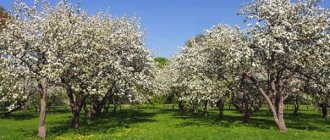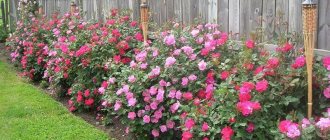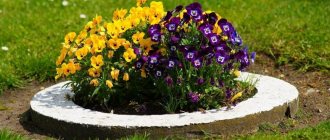Lawn care takes a lot of effort, and you are no longer glad that you decided to organize a lawn in front of your house? Sow a Moorish lawn! It only needs to be mowed twice a season, but it is highly decorative.
Wildflowers are cute, beautiful and... worthy of a whole trend in landscape design. The so-called Moorish lawns are nothing more than areas sown with herbs and all kinds of daisies, poppies, cornflowers, etc. This is an imitation of the expanse of fields and a response to the desire of modern man for everything natural and natural.
Plants for the Moorish lawn: buy or make a mixture yourself?
On sale you can find ready-made lawn mixtures with flowering herbs. They can be called differently - Moorish mixture, Alpine, flowering, etc. They are usually 70-90% cereals and herbs, with the remaining 10-30% flowers.
But you can create a mixture for such a lawn yourself. The easiest way is to take lawn grass as a base and mix in the seeds of any flowers that you want to admire on your site.
To ensure that the lawn looks exactly like a lawn, and not a flowerbed or a purely green playing field, maintain the proportions between flowers and herbs (they should be the same as in store-bought mixtures).
Popular options for Moorish lawn
Select the composition of the mixture carefully, because it determines how the lawn will look, as well as the duration of flowering. The following lawn options are popular:
- high , i.e. consisting of tall plants, incl. cereals;
- low , based on low-growing herbs and flowers;
- monochromatic , with flowering plants of the same color;
- variegated - the brightest lawns with a variety of cereals and flowering plants of different colors and shades.
Even if you want to create a one-color lawn, select plants with different flowering periods for it. Otherwise, the Moorish lawn will quickly lose its decorative effect and take on the appearance of an unkempt area.
Choosing plants for a Moorish lawn
When choosing plants for a Moorish lawn, do not forget that this is still a lawn, not a flower bed. Therefore, its main area should be occupied by cereals and herbs. Plus, the more flowers there are, the more difficult it is to maintain an herb garden. The following types of grass behave well in mid-latitudes:
- wheatgrass;
- fragrant bison;
- lagurus;
- meadow bluegrass;
- perennial ryegrass;
- timothy grass;
- red fescue;
- bentgrass
An important rule for mixing is to choose plants that thrive in each other's company.
However, without flowers, the lawn will lose its decorative value. Therefore, dilute the herbs with your favorite annuals and perennials, as well as early-flowering bulbs.
| Flowers for the Moorish lawn | ||
| Bulbous (early flowering) | Annuals | Perennials |
|
|
|
Let us once again remind you of the importance of choosing flowers taking into account their flowering time. The spring brightness of colors will be provided by bulbous plants, and then annuals and perennials will take the baton. It is their choice that needs to be approached as responsibly as possible.
Ideas from the designer
There are several more ways to create decorative lawns, which are recommended by I.K. Barysheva. They are somewhat more difficult to perform, but the result is worth the effort.
Either a meadow or a corner of a garden.
Meadow lawn, or cultivated meadow
Compound:
- ready-made mixture “Ordinary lawn”;
- red and white clover;
- alfalfa;
- sainfoin;
- You can add small bulbous flowers and small annuals.
Flaws:
- does not tolerate prolonged trampling;
- it cannot be arranged everywhere, only along the periphery of the site;
- due to the large number of weeds it looks untidy;
- more difficult to create than a regular lawn.
Pros:
- can be cut once a month;
- The decorative effect is increased due to the fact that such a lawn is cut higher than a regular one, and this cutting allows you to create good decorative lines in the landscape.
Clover is included in many flower lawn mixtures
Advantages and disadvantages of Moorish lawn
Many summer residents are happy to create Moorish-style lawns on their plots. Others are skeptical about the idea. Let's figure out what the “pros” and “cons” of this landscape solution are.
5 reasons to sow a Moorish lawn
- Highly decorative and an abundance of colors . The Moorish lawn is a carpet of flowers and herbs, the ornament of which you choose yourself. This can be a monochrome landscape solution or an incredibly colorful picture.
- Possibility to improve an area with poor soil . Plants for the Moorish lawn are, as a rule, unpretentious. They grow even where any other crops die. Therefore, if you just can’t find a use for an area with poor soils, turn it into a flowering lawn.
- Minimal care . The lawn needs to be mowed 1-2 times per season. At the same time, the plants are resistant to drought, and the flowering period lasts almost the entire summer. The annuals then scatter their seeds, allowing the lawn to seed itself next year. And even if individual bald spots appear, they can be easily hidden by planting annuals or fast-growing flowers there.
- Continuous flowering . By carefully selecting the composition of your lawn seeds, you will enjoy a vibrant lawn for a long time. After all, after some plants bloom, others bloom. At the same time, the lawn is not only constantly beautiful, but also looks different throughout the summer.
- Self-renewal . Moorish lawn is a perennial landscape solution. Having sowed the seeds once, you can practically not bother yourself with it in subsequent years. In the intervals between cuttings, the seeds have time not only to ripen, but also to be sown.
And 5 reasons not to do it!
- Aesthetics for everyone . Despite all its naturalness, the Moorish lawn is hardly suitable for decorating the entire garden. The fact is that most of the year he looks unkempt. In this regard, the optimal place for it is the background of a regular lawn.
- Difficulty in making a mixture . Summer residents with little experience in growing ornamental flowering plants can easily make mistakes in preparing the mixture, not taking into account the height of the herbs, flowering time, and frost resistance. This is fraught with the fact that some crops will kill others, as well as the risk of freezing of some species.
- The exclusively decorative nature of the lawn . Unlike a classic lawn, you cannot play active games on a Moorish lawn, because... flowers are not resistant to trampling.
- To control the size of the lawn . Despite all the unpretentiousness, you still have to monitor the condition of the lawn. Without proper supervision (especially on fertile soils), you risk getting a real wild meadow. In view of this, forbs are often sown in small island-clearings.
- Allergies and dangerous insects . Many plants that are often used for Moorish lawns are honey plants and will therefore attract bumblebees, bees and wasps. Not everyone will like relaxing next to buzzing and biting insects. In addition, some wildflowers produce a lot of pollen and can cause an allergic reaction.
Peculiarities
The ideal English lawn looks impressive, but is quite boring. Bright Moorish attracts with its naturalness and restrained beauty.
Benefits of a flowering lawn:
- simple care, minimum agrotechnical measures;
- to give a pleasant appearance, you only need to mow the area once - during the growing season;
- easy to select herbal and flower mixtures;
- the number of plant species suitable for creating a variegated meadow at the dacha reaches forty;
- a beautiful corner can be easily created on insufficiently fertile soil;
- weed growth is quite slow;
- You can arrange a Moorish lawn even in a small area.
Creating and caring for a Moorish lawn
Making something from scratch is always easier than redoing it. This rule also works with Moorish lawns. However, if the soil on the site is very poor and low-growing and narrow-leaved grasses are already growing on it, it is quite possible to use this natural harvest. However, we will look at how to create a lawn with meadow grasses and flowers in an unoccupied area.
Creating a lawn
Preparing the soil for a Moorish lawn is carried out almost identically to how it is done for a regular lawn. The only difference is that the requirements for soil fertility are not too high, or rather their almost complete absence. It is much more important to completely clear the area of weeds. It is also desirable that the area under the flower-grass carpet be well illuminated by the sun. Otherwise, it will be difficult to achieve good density of ornamental vegetation.
Sowing time largely depends on what flowers are included in the lawn mixture. It is recommended to sow fast-growing cereals and annuals in the spring. And if you want to decorate the plant carpet with bulbs and perennials, start planting them in the fall.
By the way, there are two options for creating a Moorish lawn.
- Mix the seeds of flowers and herbs and sow evenly often . With this method of planting, not all flowers will bloom on the lawn the first year, but only some annuals. Perennials will take time to develop a root system and gain vegetative mass.
- Lay a lawn of meadow grasses, and then sow annuals - along the perimeter of the site, in islands or in any other way. If you want to decorate the lawn with perennials or bulbous plants, it is better to plant them, on the contrary, in the fall, and in the spring, replant the area with herbs.
| Features of planting work in spring and autumn | |
| Sowing Moorish lawn in spring (April - early May) | Sowing Moorish lawn in autumn (late August - late September) |
|
|
Meadow chamomile
Or common popovnik, which should not be confused with chamomile. A multicolored herbaceous plant with a height of 60 to 90 cm. The flower is recognizable: a massive yellow basket framed by white elongated petals.
It begins to bloom in March and ends in late autumn. Loves the sun. For its full growth, you should choose neutral or slightly acidic soils, and also avoid stagnant water.
Clover red
A ubiquitous plant with round flowers in lilac, purple and lilac colors. Differs from creeping clover, which has only white flowers.
Red clover grows from 25 to 90 cm and blooms from late May to autumn. Using a lawn flower will be beneficial because the plant is able to accumulate nitrogen in the rhizome, which enriches the soil. However, it is worth considering that clover is a honey plant and will attract bees to the site.
Tulips
A famous spring flower that blooms in early summer. There is only one elastic bud on the thick green stem, which opens during the day and closes at night.
There are more than 114 varieties of tulips. They are distinguished by the shape, size and type of petals, as well as color. In addition to the usual red and yellow tulips, there are pink, burgundy and even blue tulips. The tulip is quite resistant to temperatures, but loves warmth. Flowers planted with bulbs can grow in one place for up to 6 years.
Calendula
An unpretentious, annual plant, well known for its medicinal properties. Tinctures, decoctions and ointments used in medicine and cosmetology are made from the inflorescences.
In landscape design, as a rule, medicinal and field calendula are used. Medicinal calendula is small, approximately 10-30 cm, blooms from May to June. It gave rise to many varieties that differ in flowering periods and color from bright orange, golden, to peach-yellow.
Story
In the 7-8 centuries AD, when the Arabs and Moors founded their states in North Africa (see Maghreb) and Spain, their rulers - caliphs and emirs (governors of various taifa principalities) began to build grandiose palaces. Hundreds of gardeners, brought from different parts of the world, worked to create wonderful gardens and parks in which European, Mediterranean and Oriental elements intertwined. During the times of developed feudalism, a significant part of certain layers of the population of nominally Islamic principalities were Orientalized Sakaliba Slavs, who, as a rule, came to Spain from Crimea through Constantinople in various ways as mercenaries and slaves. In the 12th-13th centuries they were already quite widely represented in the military class, as well as among the workforce and servants. It is thanks to the influence [ source not specified 1900 days
] to their taste, the Moorish lawn began to more and more resemble a brightly blooming field meadow of Russian forest-steppes.
As a result, in the palace parks of the Sultans of Spain, between the neat trees, instead of the characteristic [ source not specified 1900 days
] green grass for Northern Europe, the earth was full of colors of modest, but extremely attractive wildflowers. Most of the plants that make up the Moorish lawn are excellent honey plants and attract a significant number of bees, bumblebees, and butterflies. This makes the lawn even more beautiful and gives it a special charm.
Forget-me-nots
A perennial with a branched stem, small blue, pink or white flowers are collected in inflorescences. Flowering lasts all summer and extends into September.
There are more than 45 species of forget-me-nots. Of these, the most popular are swamp, forest and alpine garden. On a personal plot you can most often find a garden plant. Flower growers fell in love with it for its endurance and the minimal care that the plant requires.
It is not recommended to grow forget-me-not for more than 2 years, as over time it grows, the flower becomes smaller and loses its appearance.
Mountain bow
In another way, Suvorov's bow. According to legend, thanks to this plant, Suvorov saved his soldiers from scurvy while crossing the Alps, because mountain onions are rich in vitamins, including vitamin C.
Onion leaves are bright green, large, up to 50 cm in length and 6-8 cm in width. Young greens are tender and soft; within 2-3 weeks they can be used for food. Later they become rougher.
Onions have an aromatic, garlic-onion taste, but due to their low yield they are of more decorative value. The plant produces a long peduncle, up to 1.3 m, with a single round bud at the top. The diameter of the flower is 2-3 cm, sometimes 5 cm. Its color is bright purple.
Flax grandiflora
An interesting fast-growing annual, up to 60 cm in height. One 3-5 centimeter flower blooms for only a day, and the next day another one opens from the inflorescence.
Depending on the variety, the shape and color of the flowers change. They can be white star-shaped, white with a cherry center, blue with a yellow center, deep red and pink, salmon and apricot.
Flax reproduces by self-sowing, but you can collect some seeds for next year. It blooms from July until frost, but is very dependent on the number of sunny days.
Daisies
The first daisies bloom already in April, and flowering continues until autumn. The variety of varieties allows you to choose the flowers most suitable for your garden.
The height of daisies can be from 10 to 30 cm, and the flowers can be both small (1 cm) and large (8 cm). The flower is double, white with a yellow core, red, bicolor.
Although daisies are perennials, gardeners specifically limit their lifespan to 2-3 years to prevent degeneration. The plant needs constant watering, it will take fertilizer well, but can do without additional feeding.











